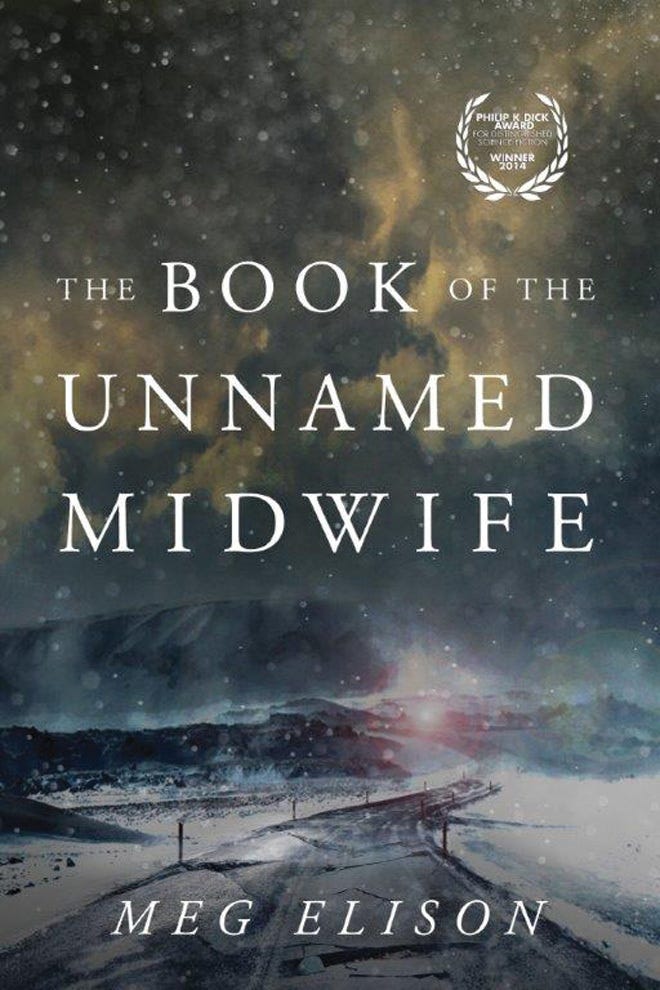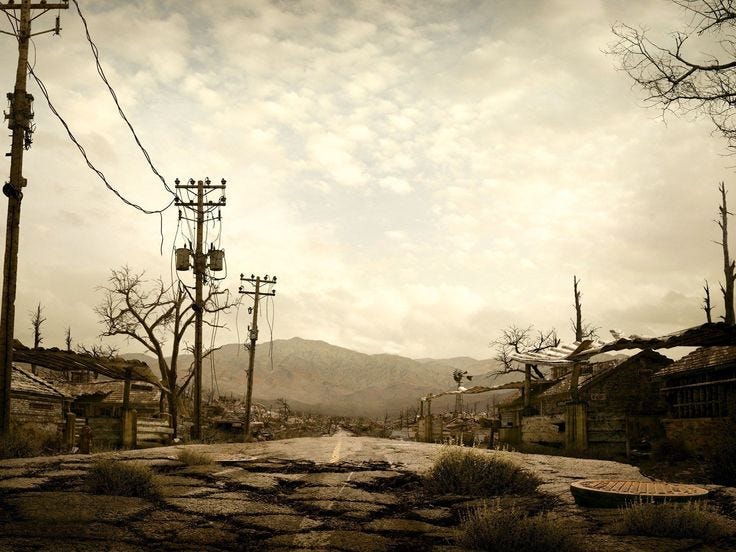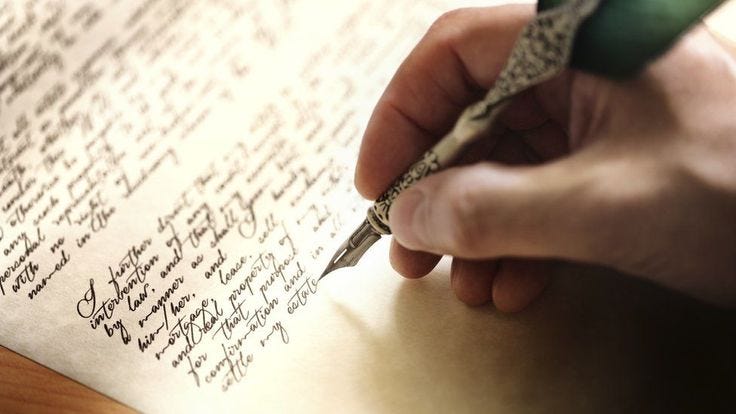Hope and Faith During The Apocalypse
Appendix 2: Summary and Review of The Book of the Unnamed Midwife
“It does no good to tell a beautiful woman how beautiful she is. If she already knows, it gives her power over the fool who tells her. If she does not, there is nothing that can be said to make her believe it.”
Meg Elison
**Spoiler Alert and Trigger Warning. In this review, I will discuss some elements of SA which are in this novel. Please read with caution and discretion. Affiliate links are also included**
Over the last several months, I have been gradually working my way through popular dystopian novels, such as 1984, Animal Farm, and The Handmaid’s Tale. Similar to my recent love for memoirs, I am finding a new appreciation for dystopian novels and what they might offer. They are still infrequently read. However, in conducting my 2024 reading awards, I realized that I have read more dystopian novels in the last 18 months than expected. This greatly surprised me as I had not intended to read as many as I had in the last year.
It was surprising as I remember the last time I intentionally read a dystopian novel — and well, it has been 10+ years. It was in middle school and I had read the first Hunger Games novel. To be totally and honestly frank, this novel left me feeling horrified and disgusted. Who would ever want to kill children for their pleasure and entertainment willingly? In hindsight, I suspect that was probably the point of that series. But, 12-year-old me wouldn’t understand the nuances quite yet, so I put aside all dystopian novels. And being the quirky homeschooled kid I was, I never actually took a literature class requiring I read any classic dystopian novel. I also never read any of these works in college, because guess what? They assumed we all read them in high school!
So, to my great dismay, I have never read any Orwell or Bradbury until this past year. I still have yet to make my way to Bradbury’s Fahrenheit 451…….Sorry to my other well-read English majors out there. I recognize that I am missing a huge part of our education.
You are not here to hear about the embarrassing gaps in my literary education (if you are, sorry to disappoint you…). Let’s get into the most recent dystopian novel, The Book of the Unnamed Midwife!
The Book of the Unnamed Midwife, the first in a trilogy, is a dystopian novel set in the immediate wake of a mysteriously destructive fever that decimates the human population. In particular, women and children are the most susceptible, as the fever makes childbirth deadlier than before; in the aftermath, no children survive birth, with many women dying soon after as well. The midwife must pick her way through a landscape where men seek to destroy and control by fear, an uncivilized world in which women become a precious rare commodity for the pleasure of men. The unnamed midwife must don new names and clothes to survive — and quite possibly save humanity.
One item worthy of note is that the unnamed midwife experiences an unsuccessful sexual assault early on in the novel. She does manage to kill the assailant and escape, but please take note this event is described on the page. There are other mentions of similar atrocities occurring off-page as well. So, please do not read this book if any of that would be triggering. I did skip the chapter once I realized what was happening, but still not enjoyable to know what happened.
For the remainder of this review, I will also use Dusty to designate the book's main character and occasional narrator. Using the unnamed midwife's self-selected identity feels appropriate for consistency and clarity. It almost feels like respecting her strength and resilience in using an identity that ensures her survival among dangerous men.
At the core of the work, the main premise is not the physical destruction of humanity but the future of humanity as symbolized through humanity’s inability to establish a lineage. As a result of the mass incapability of women to bear children, humanity loses the ability to ensure its own future. From early on, the reader is soaked in the despair of the post-apocalyptic world where all newborns die and so do their mothers.
Elison does an excellent job convincing her reader that the world of Nowhere is well within the realm of possibility. Unlike other dystopian novels I’ve read, this one had an uncannily similar quality in its world-building and characters.
I have not experienced the feeling of verisimilitude that this book exudes in a very long time. From the horror of first discovering the decimation to her strict avoidance of men, I could imagine myself experiencing all the same events as Dusty, one of the names the unnamed midwife utilizes in the narrative.
Oh, but what is verisimilitude?
When you take away verisimilitude, you do not automatically find the veridical but, perhaps, the implausible.
Jean Baudrillard
Generically, verisimilitude can be defined as how probable or realistic something is.1 In literature, this concept refers to how convincing a narrative is regarding our reality; the literary world must create a sense that the events could be genuine. 2 The more verisimilar a novel is, the book does a greater job of drawing the readers into a world that feels authentic and plausible, regardless of whether it is fictional or fantastical.3 This quality can evoke a powerful sense of connection, blurring the boundary between fiction and the reader's own life. Strong character motivations, realistic settings, and natural dialogue can all contribute to a story's verisimilitude.4
Verisimilitude is critical since, without this element, authors will have the impossible challenge of convincing their readers. Convincing their readers of what? That their literature resembles reality even in the most exciting scenarios. Think of verisimilitude as the fictional version of a nonfiction essay you might write for an English course. You build your argument — your verisimilitude — through concrete details, emotions true to your characters, blending of familiar and unfamiliar, technical prowess; the list goes on. 5
It is these things that make books like Fourth Wing and Harry Potter feel so nostalgic and homelike. Their respective authors built their literature with an excellent sense of verisimilitude.
The Book of the Unnamed Wife can be added to that running list of books that feel like home without actually being home :) All thanks to verisimilitude.
Hope Without a Future
Every man in Huntsville remembered another life, expecting to come home every day to find someone there. All the empty houses sat. No one numbered the silent days.”6
Now that you are familiar with verisimilitude, I can rave about how much this book has convinced me that our world is not so far from such devastation and death. I can say this as someone who has lived through the COVID-19 pandemic and lockdown only five years ago (can you believe it has been FIVE years?!). The pandemic utterly rewritten our sense of time and community. We watched as bustling neighborhoods turned into ghost towns, and the connections we once took for granted became strained or lost. If the pandemic had unfolded in a slightly different way, we might have found ourselves in a reality disturbingly close to that of Nowhere.
Through my firsthand experience of a global pandemic, the events of this novel strike me as far more believable. The uncertainty, the fear, the longing for a semblance of normalcy—all of these are woven into Elison’s world, and they echo what we as a global community have already endured. What amazes me is that this novel was written in 2014, years before COVID-19. I can’t help but think about how different the perspective of a pre-COVID reader would be compared to those of us who read it now. This is the transcendent beauty of literature: the meaning of a story shifts as the world and its readers change. Our unique contexts inevitably inform how we react to the messaging of every work we read, making the experience of literature deeply personal and endlessly evolving.
In reflecting on the message of this novel, I couldn’t help but notice the undercurrents of hope in the face of utter despair. Dusty’s struggle to survive in a hostile, unforgiving world is told so vividly that you as a reader feel like you are walking alongside her, sharing the burden of isolation and loss. Yet even in the bleakest moments, Elison threads hope into the narrative—a hope that Dusty herself desperately struggles to resist.
“She tried to keep hope out of her, shutting all the doors and locking them with the keys of reason and evidence and precedent. Still, she could feel it seeping in, incorporeal and deathless, refusing to be refused.”
What struck me about this story is how deeply human it is to reject hope when despair threatens to drown you. Without the promise of safety, stability, or even survival, hope can feel childish—a privilege and risky indulgence. Dusty’s rejection of hope is a form of self-preservation, a protective barrier against further heartbreak in a cutthroat world with no guarantees. And yet, as Elison shows, hope is persistent. It seeps through the cracks, no matter how tightly we lock the doors and throw away the keys.
I think about how many of us faced similar struggles during the pandemic. Confronted with uncertainty and loss, it was tempting to shut out hope and settle into survival mode. Hope meant vulnerability, and vulnerability meant more potential for pain. But even in our darkest moments, hope has a way of sneaking back in when you least expect it.
They lit candles against the dark and waited. Without birth, life is only that wait.”
This imagery of candles struck me as a profound metaphor for hope. The flame is fragile and easily extinguished, but it is also a defiance of the dark. Lighting a candle—however small—becomes an act of resistance against despair. Dusty’s waiting, though it seems passive on the surface, carries an undercurrent of quiet rebellion. To wait is to hope, even when hope feels futile.
In the absence of thriving, she chooses to wait. What else is there to do? Certainly, no one can return to life as it was before—before the empty houses, the constant reminders of life’s fragility, the weight of loss. Waiting, in its way, becomes a bridge between survival and the possibility of something more.
This novel makes us confront an essential question: In the face of devastation, what is it that keeps humanity lighting candles to wait in the face of utter desolation? Perhaps it is that stubborn, incorporeal, deathless hope that refuses to be refused.
Elison’s Criticism of Faith
“There is no argument to be had with faith.”
One final note is Elison’s presentation of the fundamentalist LDS (Mormon) community that Dusty is taken in by; I use the lower f, fundamentalist, as the community originally has qualities similar to both the mainstream LDS church and the FDLS sect. Given that this novel is considered (third-wave, to be clear) feminist, the presentation of the community is less than positive on the whole. However, Elison does do an excellent job of making her condemnation a tad more subtle compared to other authors I’ve read, including Margaret Atwood.
As a Catholic, I have fundamental theological differences with the Church of the Latter-Day Saints. I cannot condone or support several of their theological tenets. With this in mind, I encourage everyone to think about their faith and engage with others of different traditions even if it results in fundamental disagreements.
However, there is a difference between a kind yet fundamental disagreement and an active, uncharitable condemnation of a faith tradition. Naturally, there are exceptions to this as there are universal items worth public and unilateral condemnation. The FDLS sect I mentioned earlier ought to be publicly condemned for their plural marriage, child wives, and child abuse among other horrors. Other religious sects with similar (or different yet equally awful) abuses ought to be condemned. Naturally, as exceptions, they are outliers compared to the millions of faithfully religious people in the US.
I believe that Elison does an excellent job of attempting to navigate this space between active condemnation and charitable disagreement. I say attempting as the conclusion for the LDS community is one that is unhappy and treads into FDLS-reminiscent behaviors. An elder of the community ultimately marries and forces himself on the remaining female child, who must ultimately be rescued by a couple who previously fled the community. The child is of course rescued and the elder killed, implying that the couple successfully undermined the claims of their previously beloved LDS community.
Up until this point, Elison had done an excellent job of providing examples of how some individuals chose to adapt to a post-apocalyptic world compared to Dusty. I originally read this portion of Dusty’s journey as a comparison between the secular woman and the traditionally faithful woman, two extremes trying to find a middle ground. I had hopes that Elison would continue with the strain to bring these encounters to a peaceful if yet condemning, conclusion.
But, the final scene of the pedophilic elder and charitable couple left a sour taste in my mouth. As someone who has grown up in the Church, and has wrestled with the recent abuse scandals, I have a hard time with individuals who assume male leaders within the Church have greater tendencies to be pedophilic than others. While I do not know the statistics, this assumption has an underlying implication that there is something fundamental about organized religion that heightens a person’s predilections towards pedophilia and sexual domination.
If we were to judge a whole system (faith-based or not) on the sins of the few, we would be left with little to nothing to account for. Our communities would no longer exist, and we would have to be little to fulfill us. We’d lose the bonds that make life and communal living meaningful.
The recent P-Diddy scandal is the perfect example of how religion is not the common denominator in men who are pedophilic or engage in sexual abuse. The common denominator in these men is their behaviors and how the people around them allow them to engage in such horrific actions; it’s not simply religion or any faith traditions. it is the fact that they are sinful human beings enabled to enact horrific abuse in whatever system they are in.
I am by no means condoning their behaviors. They ought to receive death for abusing people in the ways they have. There is a special place in Hell for pedophiles and sexual offenders, and I will stand by that until I die.
In any case, Elison’s portrayal of faith and the LDS community creates an interesting tension between charitable disagreement and rightful condemnation in an attempt to critique systemic abuses propped up by human sinfulness.
In conclusion, Meg Elison delivers a hauntingly realistic world that confronts humanity's fragility and the moral complexities that arise in its darkest moments. Through its honest depictions of survival, societal breakdown, and resilience, the novel challenges us to reflect on how we take life for granted. Elison’s nuanced approach to faith, hope, and despair—though imperfect—sparks meaningful dialogue about the human condition and our ability for both harm and healing.
While some elements, particularly the portrayal of the LDS community, left me unsettled, they prompted me to consider how literature navigates the fine line between critique and stereotype. Elison’s work resonates deeply with our post-pandemic reality, making its themes of loss and hope all the more poignant.
Ultimately, this novel is not just a cautionary tale but a mirror reflecting our vulnerabilities and strengths. It’s a compelling read for anyone willing to confront the uncomfortable truths about humanity
“Verisimilitude Definition & Meaning,” Merriam-Webster, accessed January 6, 2025, https://www.merriam-webster.com/dictionary/verisimilitude
“Verisimilitude (Fiction),” Wikipedia, accessed January 6, 2025, , https://en.wikipedia.org/wiki/Verisimilitude_(fiction).
“What Is Verisimilitude? Verisimilitude Definition and Literary Examples of Verisimilitude - 2025,” MasterClass, accessed January 6, 2025, https://www.masterclass.com/articles/what-is-verisimilitude.
“What Is Verisimilitude? Verisimilitude Definition and Literary Examples of Verisimilitude - 2025,” MasterClass, accessed January 6, 2025, https://www.masterclass.com/articles/what-is-verisimilitude.
What Is Verisimilitude? Verisimilitude Definition and Literary Examples of Verisimilitude - 2025,” MasterClass, accessed January 6, 2025, https://www.masterclass.com/articles/what-is-verisimilitude.
All following quotations are taken from Meg Elison, The Book of the Unnamed Midwife (Seattle, WA: 47North, 2016).








